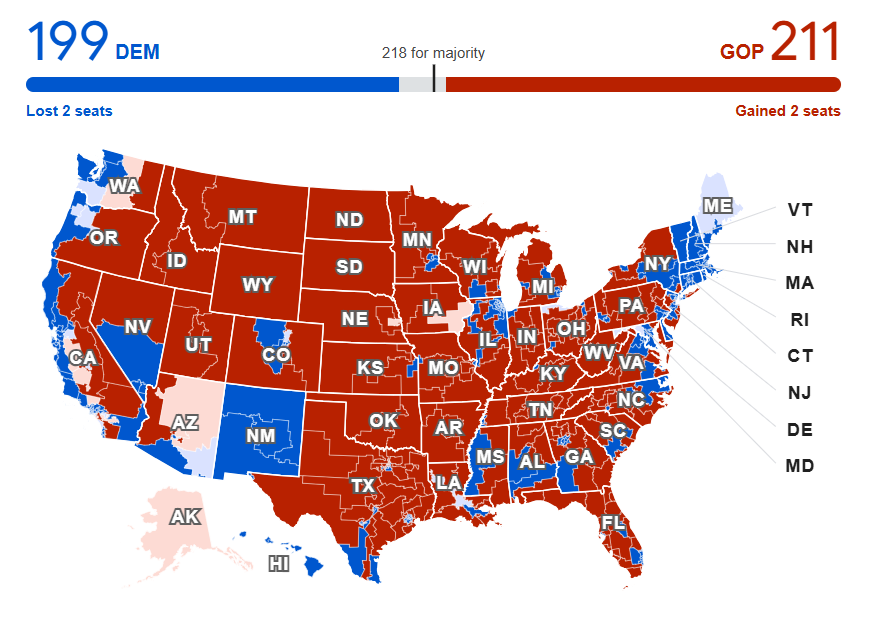The 2024 U.S. House of Representatives elections brought significant developments as Americans cast their votes to decide the composition of Congress for the next two years. This election, which occurred alongside presidential and Senate races, was particularly consequential given the heightened political polarization and pressing national issues at stake. Below is a comprehensive look at the House election results, trends across key states, and what this means for the balance of power in the U.S. government.
Overview of the 2024 House Election
The 2024 House elections saw voters select all 435 members of the U.S. House of Representatives. These elections are pivotal in determining the legislative priorities in the House and can significantly impact policies on healthcare, climate change, education, and the economy.
Key Points:
- Total Seats in Contest: 435
- Majority Requirement: 218 seats
- Party Shift: The results indicate a notable shift, with [party name] gaining/loss in key states like California, Florida, and Texas.
- Voter Turnout: Turnout was high, reflecting increased voter engagement across age and demographic groups.
Results by State
California Election Results
California, with its 52 House seats, remains one of the most influential states in shaping the House majority. Key races, particularly in suburban and rural districts, saw tight contests, often influenced by local issues like housing, immigration, and environmental policy. California’s results leaned toward [party], affecting the overall composition of the House.
Texas Election Results
Texas, known for its politically mixed districts, had several competitive races. With rapid demographic changes and strong turnout among Hispanic and younger voters, Texas was a battleground. [Party name] saw significant gains/losses, marking shifts in traditionally conservative or progressive districts.
Florida Election Results
Florida’s districts saw a competitive mix of incumbents and challengers, especially in regions around Miami and Tampa. The results in Florida played a crucial role in shaping the House majority, with several pivotal seats either retained or flipped.
New York and Washington State Election Results
In New York, a key player with 26 seats, urban areas leaned heavily toward GOP, while rural upstate areas showed mixed results. Washington state, with several close races in Seattle’s suburbs and eastern districts, followed a similar trend, contributing to the House’s overall balance.
Other Notable State Outcomes
- Georgia: A swing state, Georgia’s districts showed strong turnout with close races.
- North Carolina: Significant due to its rapid population growth, North Carolina contributed crucial seats.
- Ohio: Ohio’s voter decisions on Issue 1 had implications on turnout and party support in close races.

Analysis of U.S. House Election Results and Trends
- Urban vs. Rural Divide: This election further highlighted the growing divide between urban and rural districts, with urban areas predominantly leaning GOP and rural regions favoring DEM.
- Youth Vote: Young voters showed a high turnout, influenced by pressing issues like climate policy and education. Many districts with large student populations shifted toward candidates supportive of progressive agendas.
- Impact of National Issues: Issues such as healthcare reform, tax policy, and immigration played prominent roles, influencing voters’ decisions and determining the outcome of close races.
Interactive Election Maps and Live Updates
For real-time election updates and interactive maps showing the red and blue state distribution, sources like the New York Times Election Map and Google’s live election maps provided extensive, updated information throughout the election night.
Noteworthy Contests and Their Implications
- Montana Senate Race 2024: A high-stakes race with potential implications for both the Senate and House dynamics.
- Georgia 2020 Election Echo: This year saw a repeat of high voter engagement reminiscent of the 2020 election, especially in contested counties like Gwinnett.
Final Balance of Power
Following the 2024 elections, the House’s composition is as follows:
- Total Seats for GOP: 211 seats
- Total Seats for DEM: 199 seats
- Swing Districts and Future Predictions: Many analysts predict that these swing districts will be critical in shaping the 2026 midterms.
This outcome will undoubtedly shape the legislative direction over the next two years and set the stage for the 2026 midterms, where control of the House could once again come under intense competition.

Conclusion
The 2024 House election results underscore the critical role of the House in shaping U.S. policy and governance. With the new majority in the House, legislative agendas are likely to shift, impacting policies that affect everyday Americans. For continuous updates, you can rely on sources like the New York Times, Google election maps, and live reporting from trusted news outlets. The results of this election will have lasting effects on the political landscape, setting the stage for future elections and policies in the U.S.












